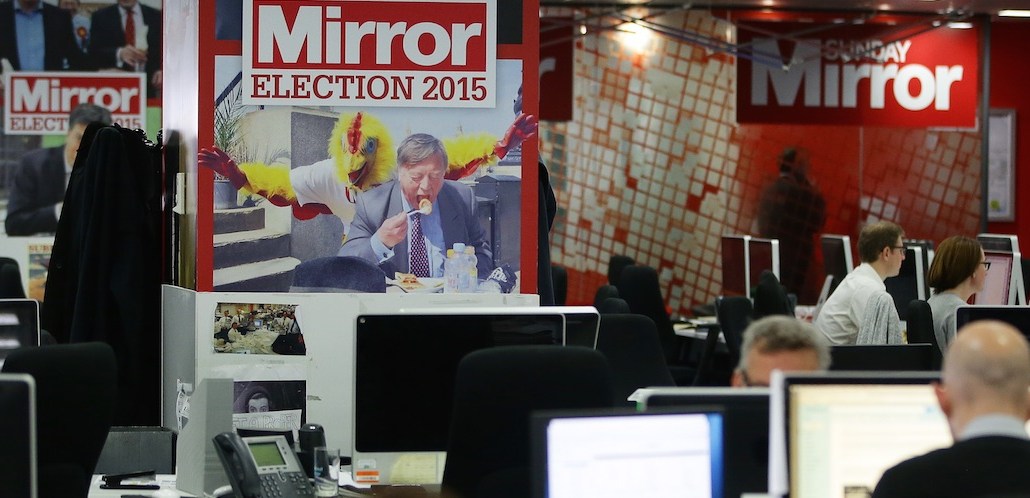Save 50% on a 3-month Digiday+ membership. Ends Dec 5.

Speed is a battleground for publishers. And Trinity Mirror has just fired a shot across the bow: The publisher of over 50 news sites, including flagship national tabloid The Mirror, has spent nine months cutting the load time of its websites in half to two seconds.
Five of its regional sites are running on the new design, including The Wharf and Get Reading. The Mirror will adopt it next month but is currently showing the new design to 5 percent of its readership on its article pages only while it gathers user feedback. The majority of the sites will have the new design by the end of this year, although the publisher explained that the change in design has been more of a byproduct of improving the technology behind it.
The design changes, led by about a third of Trinity Mirror’s 100-person product team, are most apparent in the homepage where much of the text has been replaced with images. In some of the regional sites like Get Reading, the right-hand live-blogging column has been replaced with recent stories. The top navigation bar remains the same but is more prominent, and the news stories are more clearly arranged in card format.
The incentive for doing so is clear: Slow-loading pages incur higher bounce rates, make ads unviewable and push people to install ad blockers. With the new design, “the perceived page load (loading the first screen full, rather than the full page) is now close to two seconds, compared to more than four seconds previously,” Chris Russell, product director, Trinity Mirror Digital told Digiday.

ComScore puts The Mirror at 21.2 million monthly uniques, and Trinity Mirror at 27.7 million overall, without duplicates. Trinity Mirror has also invested in Google AMP and Facebook Instant Articles, which account for 10 percent of its traffic, but its own properties remain a key priority.
Building the new front-end from scratch means Trinity Mirror can make the trade-off between adding third-party code and the benefits it gets. For instance, one A/B testing tool it uses adds a quarter to half a second onto the perceived page load. Previously, this code was sitting there regardless of whether a test was being run; now, it’s only turned on when it’s needed.
Ad position: web_incontent_pos1
It also cut load time by adding slow-loading images lower down, so they only load when they come in view. Picture galleries were cut as well to favor scrolling articles.
The decrease in page-load time has led to an increase in viewability by 17 percentage points on ads at the top of the site (although Trinity Mirror Digital wouldn’t give out what the baseline is). Now, the video player is loading more quickly, and the play rate has increased by a double-digit percentage, too.
“The early indications are that when the overall site has changed the engagement, the amount of content consumed each visit and frequency over the month, does improve,” said Mary Lojkine, head of product at Trinity Mirror. Those being served the new Mirror pages can switch back to the old design. Currently, fewer than 0.5 percent are opting to do so.
One of its most popular features across its sites, not available through Instant Articles, is the live-blogging format, which follows breaking news as it unfolds, major traffic jam updates and live sports. It’s a format that goes down well on the regional titles.
“Live blogging was our first big play for speed,” said Lojkine, explaining the tool launched a year ago. “Our goal was to get the update from the journalist pushing publish to the user in under a second.”
Ad position: web_incontent_pos2
Images courtesy of Trinity Mirror.
More in Media

Digiday+ Research Subscription Index 2025: Subscription strategies from Bloomberg, The New York Times, Vox and others
Digiday’s third annual Subscription Index examines and measures publishers’ subscription strategies to identify common approaches and key tactics among Bloomberg, The New York Times, Vox and others.

From lawsuits to lobbying: How publishers are fighting AI
We may be closing out 2025, but publishers aren’t retreating from the battle of AI search — some are escalating it, and they expect the fight to stretch deep into 2026.

Media Briefing: Publishers turn to vertical video to compete with creators and grow ad revenue in 2026
Publishers add vertical video feeds to their sites to boost engagement, attract video ad spend and compete with news creators.
Ad position: web_bfu


